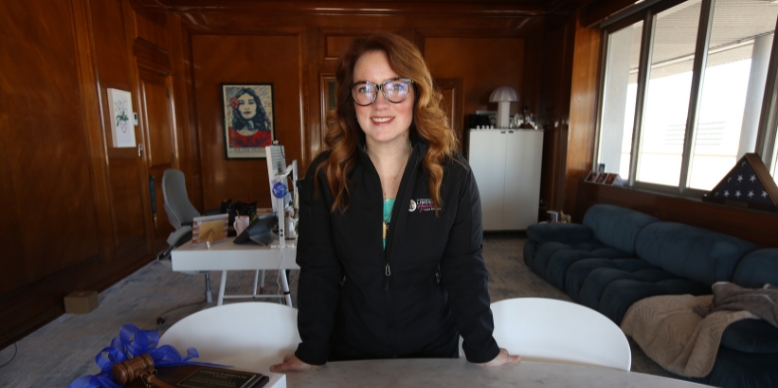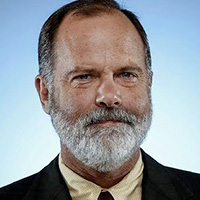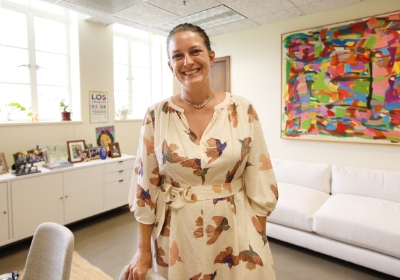Lindsey Horvath surprised much of the political establishment in 2022 when she beat Bob Hertzberg, the former majority leader of the California State Senate, to win a seat on the Los Angeles County Board of Supervisors. Horvath, a member of the West Hollywood City Council, was significantly outspent, but she prioritized fighting homelessness and protecting reproductive rights to overcome Hertzberg’s lead coming out of the first round.
Her time in office was roiled in January when the Palisades fire tore through her district. In the weeks since, Horvath has jumped to the fore, establishing a blue ribbon commission to study and make recommendations on rebuilding the area, and occasionally clashing with Mayor Karen Bass. That friction, which came to light when the Los Angeles Times published a text exchange between the two, has since been put to rest, Horvath said in this interview.
She recently spoke with Blueprint editor-in-chief Jim Newton at her offices in the County Hall of Administration. They were accompanied by Horvath’s sprightly golden doodle, Winston, who enthusiastically bounded about as Horvath reflected on her time in office, her duties and some of the challenges facing Los Angeles County.
BLUEPRINT: Were you surprised that you won your race for this office in 2022? Or did you expect it?
LINDSEY HORVATH: We definitely saw a path from the beginning. Otherwise, I wouldn’t have gotten into it, but I think people are making choices in politics now to meet the moment. Senator Hertzberg had demonstrated the kind of leadership that people had known for many years. In this particular moment — and as we’re seeing in our politics, continue to play out — people are looking for something a little bit different, for whatever their reasons.
We offered that “something different” for people. Not everybody really understands the role of a county supervisor …
BP: Agreed.
LH: So one advantage we had was coming from local government, having that connection to someone who understands what it means to be on the ground, being hands-on. At the time, the crisis that people were focused on was homelessness. I had done a lot of work on that in West Hollywood.
And now, of course, with the fires, we’re seeing how knowing the way to do emergency preparedness and get people connected to resources and information, that’s what people are looking for in this moment. And I’m grateful to have the opportunity to do it.
BP: How has the experience of being in office compared to what you thought it would be? Any surprises?
LH: People talk about the combination of the executive and the legislative authority in this role, but to experience it in practice, it’s unlike anything I’ve ever experienced. And I don’t think there’s anything quite like it.
I guess I don’t know exactly what I expected it to be. It was more just about being ready to show up for whatever came our way. We knew the bigness of the district and also the responsibilities that this role comes with.
We have more than 30 departments. We are the social safety net. We have more than 2 million people in my district and 10 million in the county. … I don’t know that I was terribly surprised, but I’m always learning new things about the role.
BP: How do you imagine things changing now that Measure G has passed, and the board will expand, as well as adding an elected county-wide chief executive?
LH: For those who are engaged already, we had departmental budget hearings, which is the first time it’s ever happened in Los Angeles County. …
The next phase of rolling out Measure G is that, by the end of next year, we have to establish the Ethics Commission. … We’ve seen that there are ethics commissions or some type of entity at other levels of government, so that experience will help inform what it is, or isn’t, for Los Angeles County, because people haven’t gotten savvy. It’s not just that it exists, but what authority does it have, and how will it change the way we do business as a county?
My hope, my big dream, is that Measure G will engage more people into the work of the county. I heard pretty consistently as I was running that people didn’t know what the county did. … This process hopefully will help people understand what the county is actually responsible for, and how it should be showing up differently for them.
BP: So, let’s talk about the fires. First of all, are you OK? Were you or a loved one affected by the fires?
LH: Thank you. I’m fine. And you? You live in Pasadena?
BP: Yes, thank you. We’re fine, too, though it was a little touch and go there for a bit.
LH: Yeah, I live in West Hollywood, and the Sunset Fire was sort of in that area. I called our chief and said, “I just got an alert,” which I never thought I would get where I live. He said, “We’re just letting people know because we saw the slow evacuation for people who were impacted.” And so they expanded it quickly just to encourage people to move. He had advised that if it got down to Hollywood Boulevard, it was going to move pretty quickly into our area.
And so I looked around my house, thinking “What am I going to take?” What memories do you leave behind? The fact that anyone had to make a choice like that is just awful.
BP: What do you consider your responsibility in this moment? I mean, we don’t really hold elected officials responsible for disasters. We don’t look back and say [Mayor] Dick Riordan was responsible for the Northridge Earthquake. But we do expect things of elected officials in the face of disasters. What do you expect of yourself?
LH: Our responsibility is to make sure plans are in place. … Making sure that people know what we have invested in, in terms of communication systems, in terms of emergency response. How they should plan for evacuation routes. … We’ve done emergency preparedness training throughout the district.
We try to do that outreach so that people aren’t entirely caught flat-footed. Of course, we know not everybody does emergency preparedness, so sometimes it’s then that we’re judged by [this instead]: In that moment, how did you show up and help people evacuate?
So it’s making sure that [people] know how to respond, that we have the expertise on the ground so that, when they start getting those notifications, we stage appropriately, call in the appropriate resources, and communicate about what we all need to be responsible for. No one person is responsible for the totality, but as the elected for the region, my responsibility is to be sure that we’ve been having those conversations, and that we put our best foot forward in terms of being prepared to respond.
BP: And it’s safe to say that there’s going to be some friction in all of that. I know that you and Mayor Bass have not always seen eye to eye in all of this. How are your relations with the mayor and the mayor’s office?
LH: We’re fine. There are moments of frustration, I would say, in any sort of major disaster. You don’t want to see them on display as they were made. I think it’s also important to communicate and to do better going forward.
When we had the chance to speak about all of that, which was long before it was revealed to the public, I just said: “Here’s how it landed with me and why it was so difficult to navigate.” And she acknowledged that, and we both acknowledged that there was a better way to coordinate. … That has changed. There’s [now] even more intentional coordination between city and county.
BP: It feels like there are almost opposite demands on people in your position. On the one hand, there are some who want you to be a strong leader and grab a bull by the horns and ignore all the noise and plunge forward, and on the other hand, there’s the obligation to be multi-institutional and make sure there’s good communication, etc. I’m not sure whether the public has one point of view on this, or whether it has many expectations, some of which are just destined to not be fulfilled.
LH: You’re absolutely right. There are times where people are like, “Just decide already.” And we don’t want to get immobilized by indecision. But I also think that when you are leading in Los Angeles County, there are 88 cities, there are 200 water agencies, there are all kinds of public safety agencies. The Sheriff’s Department serves 50 cities, but that means there are that many more police departments.
So when you’re at a more regional level in terms of your leadership, you have a responsibility to make sure that when you are making those decisions, you are prepared for that ripple effect …
It’s fair to ask for both. And with each of our decisions, we have to justify why we took one approach over another.
When it’s about people’s health and safety, you have to act swiftly. And then we’re going to do an after-action to see how well we did, what could we have done better, what should we change as an institution.
BP: What are your hopes for the commission that you’ve created? What would you like to see come out of that group and that process?
LH: The Blue Ribbon Commission is comprised of experts in a variety of areas, not only in terms of how we rebuild in a green way and green building standards but also from the finance sector, from the insurance sector. As we think about what affordability is, going forward, a key component of that is going to be insurability.
Now that we are in this moment where there has been such severe devastation, how do we insure that we’re not just racing to build back what is there — obviously moving with speed, but also with thoughtfulness about what we should be doing intentionally to build back better, with resiliency and fire safety in mind? That’s really the focus and the charge of this commission.
BP: There’s a lot of talk of “reimagining” these communities, but when I talk with homeowners, people who have lost a home, their response is, “I just want to rebuild. I’m not that interested in reimagining this place,” whether it’s the Palisades or Altadena.
LH: Yep.
BP: Are those things at odds with each other? Is it possible to do both?
LH: I think you have to do both. While people are saying they want to get back quickly, I don’t know any person who hasn’t considered whether they would get insurance going forward.
If we help ease the financial burden of some of these home-hardening and fire-hardening best practices, and we allow them to still move quickly — they are still going to get their virtually rubber-stamped permits if they bring that into the footprint of their rebuild. Will they do it? How can we incentivize that? …
That’s something we believe this Blue Ribbon Commission can illuminate for us — what that pathway ought to look like. We already heard, from the insurance perspective in the rebuild process, if something isn’t codified in policy, they may not cover it in the rebuild. So we think we’re being brilliant by “cutting through red tape” to make it easier to rebuild. But if we, say, take away the requirement to include solar panels in the rebuild, they may not cover it because it’s not required.
How do we make sure that, in our efforts to move quickly, we don’t do so thoughtlessly, and without intention around insurability? I heard from one of my residents in Malibu who lived through [the] Woolsey [Fire] and now volunteers in the community brigade, “I don’t want to be doing this again in four years.”
I appreciate the concept of building back quickly, … but we have to do it intentionally, not only for our individual properties, but also for our whole community, because if we’re just building back what we had, we might be putting ourselves at risk, putting our firefighters at risk, and so many other things.
I don’t think anyone here is thinking about this as an academic exercise. … We don’t have time for that, but what we do have time for is taking the lessons we already know and expediting them into actionable policy. That’s what I believe this Blue Ribbon Commission will do.
BP: What’s the timeline? As you look forward, what’s a reasonable hope or expectation for feeling like things are getting back to normal?
LH: Our focus on the schools has been critically important. For lots of families, having a school system that serves our families is almost as important as the homes they want to rebuild.
BP: I’m sure that’s right.
LH: And I know that the mayor has, on the rebuild side, in the city, prioritized what the town center looks like. That’s particularly important to not just the local economic engine but also the sense of community.
BP: It was the center of that place.
LH: I also hope there is a role for our faith leaders to play. They’ve come to the table and shared with us how they’ve been stewarding their congregations from a spiritual standpoint — and just trying to help people heal. … They are crucial to how a community functions.
BP: One set of victims of these fires has been children, and I wonder if we could talk a bit about the county’s role in protecting children, particularly those children in foster care.
LH: Sure.
BP: This is going to sound terribly academic, but why is it that government should play a role at all in this? Why isn’t the care of children a responsibility, first of nuclear families, and then extended families, or communities? How does it come to be a job for the government? Is this a good function for government to perform?
LH: I don’t know the whole history of setting up the welfare system for young people, but this is something I was challenged to think about, as I was coming into this seat, by people who had given a lot more thought to it than I had, to be honest.
Can the goal be to help families stay a family unit, and keep young people supported in a family, if the family is safe but under-resourced? That’s not necessarily a safety issue. That’s a poverty issue. But when you treat it as a safety issue, you are often creating more harm than you are solving.
And yet, we know that there are young people who will have no safety net if the government doesn’t play some sort of role. … There’s nobody who’s going to take responsibility if we don’t. …
BP: When Mike Nash [presiding judge of the Juvenile Court] opened up proceedings for a while, I spent a lot of time attending hearings in the foster care system. And I must say, I was struck by mostly White judicial officers taking Black and Brown children out of their homes. I know that there’s an explanation for every one of those cases, so I’m not trying to be accusatory, but there’s something dispiriting about watching it happen over and over.
LH: Yeah, and it’s a reflection of systemic racism, and how we’ve created structures that don’t realize the disproportionate impact on those communities. We owe it to our communities to do better. …
I co-authored a motion with Supervisor [Holly] Mitchell for the county to be thinking about the prevention system. We often get described as the social safety net for the region, but what happens if we could catch people … and prevent them from falling?
That’s how we’re trying to think about that system of care that the county intends to provide, so it’s not a form of punishment but truly a form of support.
BP: I know you’ve paid some special attention to young people who are emancipating out of the system. Do you have specific things in mind that might be especially helpful to young people as they’re turning 18 or 19 and leaving foster care?
LH: One of the things they’ve crystallized for us is … they get these vouchers, or are supposed to have access to these vouchers, but the vouchers don’t translate necessarily to housing. They might be allocated, but they don’t know how to get them. And if they do get them, they don’t get a lot of assistance in finding housing that is receptive to that.
On paper, check, we’ve created a solution to that problem. But in practice, we haven’t. So how do we go the extra mile with them to actually turn that into a housing solution? … How do we just bake that into how we do our work?
BP: One last question: Trump. In the background of all of this, you have at best an unsupportive Washington. I worry that we’re entering this period where officials such as yourself may have to make a choice between being candid about how really aberrant Washington is right now and risk losing funding or holding your tongue and compromising on your principles. Are you in a position — whether it’s the fires or the Olympics, homelessness or foster care — to be able to be candid, or do you feel that you have to pull your punches?
LH: I think we’re being mindful of how we interact with the federal government, specifically for fire recovery. And I think we’ve made a commitment as a county board that we’re going to remain committed to the values that we’ve always had.
How we show up for people is what makes the difference.
As we saw in the early announcements in perhaps changes in services, … for gender-affirming care, our state leaders weighed in to say, “No, we’ve talked about this as a state, and here’s what we’re going to do.” Maybe it doesn’t become something that the federal government funds, but we as a county are going to continue to support this kind of care.
Same thing with abortion care. I come from America’s first pro-choice city, and making sure that we continue to remain an abortion safe haven in Los Angeles is something that’s critically important to me and to our region. But it’s only as safe as people actually have access to come here. So if someone feels at risk to use our Metro system to be transported … then it’s just words on paper, not in practice. …
We need to express what we see as breaking down in our community, but we also need to take action. … We need to be thoughtful and intentional about how we’re doing this work.

























